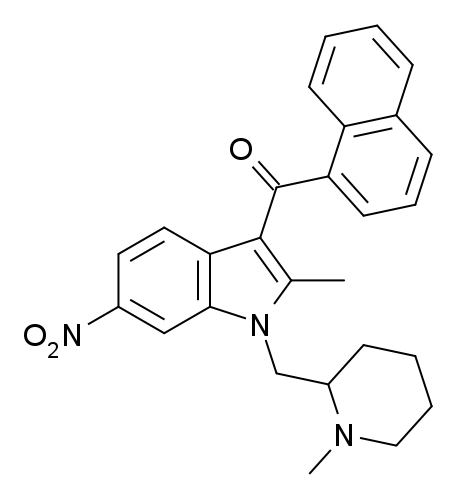Summary
AM-1221 is a potent and selective agonist that primarily targets the cannabinoid receptor CB2, exhibiting a remarkable Ki of 0.28 nM at CB2 and 52.3 Nm at CB1. This translates to an approximately 180-fold preference for CB2 over CB1. The presence of both 2-methyl and 6-nitro groups on the indole ring contributes to enhanced CB2 affinity while generally diminishing the affinity at CB1. This structural feature underlies AM-1221’s high selectivity for CB2.
It’s worth noting, however, that despite its substantial CB2 selectivity, AM-1221 retains a level of CB1 affinity that prevents it from being a genuinely selective CB2 agonist. For this reason, researchers often prefer the related compound AM-1241 for their studies.
| Identifiers | |
|---|---|
| IUPAC name | |
| CAS Number | 335160-53-7 |
|---|---|
| PubChem CID | 11604318 |
| ChemSpider | 26286945 |
| UNII | SHC6SNM293 |
| CompTox Dashboard (EPA) | DTXSID701009967 |
| Chemical and physical data | |
| Formula | C27H27N3O3 |
| Molar mass | 441.531 g·mol−1 |

Legal status
The distribution, trade, sale, import, or transportation of this pharmaceutical drug in the UK is prohibited under the Psychoactive Substances Act 2016, which came into effect on May 26, 2016.
FAQ
- What is AM-1221?
- AM-1221 is a synthetic drug known as a cannabinoid receptor agonist. It acts as an agonist for the cannabinoid receptor CB2, with high selectivity for this receptor over CB1.
- How does AM-1221 work?
- AM-1221 binds to the CB2 cannabinoid receptor, one of the two main types of cannabinoid receptors in the human body. Activation of CB2 receptors can lead to various physiological and pharmacological effects.
- What is the difference between CB1 and CB2 receptors?
- CB1 and CB2 are two types of cannabinoid receptors found in the endocannabinoid system. CB1 receptors are primarily located in the brain and central nervous system, while CB2 receptors are mainly found in peripheral tissues, particularly in the immune system. AM-1221 has a higher affinity for CB2, making it selective for peripheral effects.
- Is AM-1221 legal?
- The legal status of AM-1221 varies by country. In the United States, it falls under Schedule I Controlled Substances, making it illegal. It’s also prohibited in the UK under the Psychoactive Substances Act 2016.
- What are the research uses of AM-1221?
- AM-1221 and similar compounds are primarily used in scientific research to study the endocannabinoid system and its receptors, especially CB2. Researchers investigate their potential effects and mechanisms of action.
- Are there any health risks associated with AM-1221 use?
- AM-1221 may pose health risks, as its safety and long-term effects have not been extensively studied. It’s important to note that the legality and regulation of such substances vary widely, and their consumption can have adverse health consequences.
- What are the alternatives to AM-1221 in research?
- Researchers often prefer to use compounds like AM-1241 for studying CB2 receptors due to their higher selectivity. AM-1241 and related substances are more commonly used as research tools.
- Is there a medical use for AM-1221?
- Currently, AM-1221 and similar synthetic cannabinoids have not been approved for medical use. Research in this area is ongoing, and potential therapeutic applications are being explored.
- Can I buy AM-1221 for personal use?
- The sale and purchase of AM-1221 for personal use are illegal in many jurisdictions. Always be aware of the legal status of substances in your area and prioritize your safety and well-being.
- Where can I find more information about AM-1221?
- For detailed information on AM-1221 and related compounds, it’s advisable to consult scientific literature, research studies, and government regulations specific to your region.
References
- What is the significance of WO patent 200128557 in relation to AM-1221? WO patent 200128557, attributed to Alexandros Makriyannis and Hao Deng, relates to “Cannabimimetic indole derivatives.” This patent sheds light on the development and potential applications of indole-based compounds with cannabinoid-like properties.
- What was the focus of Hao Deng’s 2000 Ph.D. dissertation at the University of Connecticut? Hao Deng’s Ph.D. dissertation at the University of Connecticut, titled “Design and synthesis of selective cannabinoid receptor ligands: Aminoalkylindole and other heterocyclic analogs,” highlights the research and development of novel compounds targeting cannabinoid receptors.
- Are there other publications discussing compounds similar to AM-1221? Yes, there are various publications discussing compounds related to AM-1221, such as indoles and their interactions with cannabinoid receptors. For instance, “Indoles and related compounds as cannabinoid ligands” by Manera, Tuccinardi, and Martinelli provides insights into this area.
- How are controlled substances classified in the United States? In the United States, controlled substances are classified and regulated under the Controlled Substances Act. This classification determines their legal status, availability, and permitted uses.